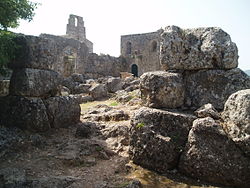Necromancy
The Nekromanteion (also Nekyomanteion , Nekyomantion or Nekromantion ) was an oracle for the dead near the ancient city of Ephyra on the coast of Greece . It is said to have been on a hill on the outskirts of the village of Mesopotamos in Epirus , in the valley of the Acheron River near the road from Parga to Preveza .
Herodotus mentions the Nekromanteion in connection with Periander , the tyrant of Corinth, who sent ambassadors who were supposed to get in touch with his dead wife Melissa in the oracle.
167 BC The oracle was destroyed by the Romans .
Excavations and artifacts
Mycenaean ruins from the 14th century BC Were discovered in ancient Ephyra 500 meters north of the presumed oracle of the dead and in the ancient coastal town of Toryne barely five kilometers away.
In 1958 the Greek archaeologist Sotirios Dakaris discovered walls up to 3.35 m thick, which enclosed a 22 m² underground space, under the ruins of a church of John the Baptist built in the 18th century and the neighboring cemetery . He interpreted these structures as the center of the oracle of the dead at Ephyra, which had been mentioned by Homer and Herodotus, but whose exact location had been unknown until then. In two longer campaigns, from 1958 to 1964 and from 1976 to 1977 Dakaris excavated the sanctuary. The building remains found come mainly from the 3rd and 4th centuries BC. Older things came to light only sporadically, for example fragments of clay statuettes of Persephone , which date from the 7th century.
In the interpretation of Dakaris, the oracle site was a compact building with thick walls. On its north side was the entrance, which was followed by a forecourt with rooms for the priests and those seeking advice. A larger room was used to prepare the pilgrims for the questioning of the oracle and the cult of the gods of the underworld. This is followed by a labyrinthine entrance area, which was once closed with several heavy bronze doors, and finally the actual cult room.
However, this interpretation of the finds was soon questioned by experts. Dietwulf Baatz said as early as 1980 that it was not a place of worship, but a fortified aristocratic residence from the Hellenistic era. An American team of archaeologists who investigated aristocratic country estates in Epirus in the 1990s also came to the conclusion that the finds from Dakaris could possibly be a large property with a fortification. In any case, the walls from the Hellenistic period cannot be related to the mentions of the oracle in the literature. It is still unclear whether there were any older buildings on the hill on the Acheron.
literature
- Sotirios Dakaris: The Nekyomanteion at the Acheron . Athens 2001. ISBN 960-214-303-7 .
- Sotirios Dakaris: Antiquities of Epirus: the oracle of death from Acheron, Ephyra, Pandosia, Kassope . Athens 1975.
- Dietwulf Baatz: Defensive living. A fortified Hellenistic aristocratic seat near Ephyra . In: Antike Welt 30,2 (1999) pp. 151–155.
- James Wiseman: Rethinking the "Halls of Hades". In: Archeology 51.3 (1998). Abstract
Web links
- Detailed German language page ( Memento from October 8, 2010 in the Internet Archive )
- Nekromanteion of Acheron (English)
- Daniel Ogden: Lay That Ghost. Necromancy in Ancient Greece and Rome.
Coordinates: 39 ° 14 '10.4 " N , 20 ° 32' 4.3" E

